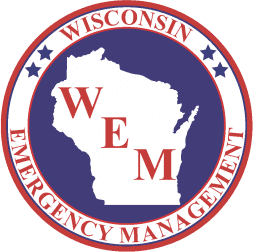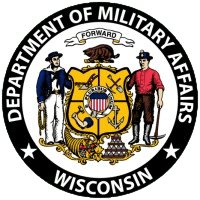 Gov. Tony Evers addresses emergency officials from across Wisconsin during the 52nd annual Governor’s Conference on Emergency Management and Homeland Security March 21-22 in Wisconsin Dells, Wis. Gov. Attendees heard reports on lessons learned from last year’s disasters in the state. Wisconsin Emergency Management photo by Andrew Beckett
Gov. Tony Evers addresses emergency officials from across Wisconsin during the 52nd annual Governor’s Conference on Emergency Management and Homeland Security March 21-22 in Wisconsin Dells, Wis. Gov. Attendees heard reports on lessons learned from last year’s disasters in the state. Wisconsin Emergency Management photo by Andrew Beckett
WISCONSIN DELLS, Wis. — Lessons learned from the disasters experienced in the state last year were shared with emergency officials from across Wisconsin, during the 52nd Annual Governor’s Conference on Emergency Management and Homeland Security. More than 400 representatives of the state’s emergency management, fire, law enforcement and other first responder agencies attended the event, held March 21-22 at the Kalahari Resort and Convention Center in Wisconsin Dells, Wisconsin.
“You’re one of these invisible armies … when the time comes for emergency planning to play out in the state of Wisconsin, Wisconsin has a lot to be proud of,” Gov. Tony Evers said as he opened the conference. “Obviously there’s a lot of coordination to make sure the people of Wisconsin are safe and sound, and I thank you for doing that behind the scenes and for doing it so well.”
 Maj. Gen. Don Dunbar, Wisconsin’s adjutant general and Homeland Security adviser, addresses emergency officials from across Wisconsin during the 52nd annual Governor’s Conference on Emergency Management and Homeland Security March 21-22 in Wisconsin Dells, Wis. Gov. Attendees heard reports on lessons learned from last year’s disasters in the state. Wisconsin National Guard photo by Maj. Joy Staab
Maj. Gen. Don Dunbar, Wisconsin’s adjutant general and Homeland Security adviser, addresses emergency officials from across Wisconsin during the 52nd annual Governor’s Conference on Emergency Management and Homeland Security March 21-22 in Wisconsin Dells, Wis. Gov. Attendees heard reports on lessons learned from last year’s disasters in the state. Wisconsin National Guard photo by Maj. Joy Staab
Wisconsin Emergency Management Administrator Brian Satula provided a review of the state’s two federally declared disasters in 2018 and several other emergencies the state experienced in the past year, including a refinery fire in Superior last April and the extreme cold the state experienced during the polar vortex earlier this year.
Satula thanked the state’s partners for continuing to share information and for working to make sure the people of the state remain safe.
“You are the people that are making things happen,” he said. “It’s so important to the people of Wisconsin to make sure you are there. Without you, the coordination of these major responses would not happen.”
Maj. Gen. Don Dunbar, Wisconsin’s adjutant general and Homeland Security advisor, explained to the audience how work is currently underway to update the state’s Homeland Security Strategy. The plan, which is updated after every gubernatorial election, helps guide the state’s goals in areas such as cybersecurity and antiterrorism.
 FEMA Region V Administrator James Joseph addresses emergency officials from across Wisconsin during the 52nd annual Governor’s Conference on Emergency Management and Homeland Security March 21-22 in Wisconsin Dells, Wis. Attendees heard reports on lessons learned from last year’s disasters in the state. Wisconsin National Guard photo by Maj. Joy Staab
FEMA Region V Administrator James Joseph addresses emergency officials from across Wisconsin during the 52nd annual Governor’s Conference on Emergency Management and Homeland Security March 21-22 in Wisconsin Dells, Wis. Attendees heard reports on lessons learned from last year’s disasters in the state. Wisconsin National Guard photo by Maj. Joy Staab
“It’s an opportunity for us to rethink what is important,” Dunbar said. “It’s a vision document designed to give a broad path to all of our state partners and help inform how we invest grant dollars in the future. It’s also important to ensure that Gov. Evers has the opportunity to guide our direction.”
Dunbar also provided an update on current threats facing the state and nation, including the risks of cyber meddling in upcoming elections. He noted how outside actors, such as those with ties to Russia, already showed a willingness to disrupt the 2016 presidential election and argued the state must be prepared for the 2020 election.
Dunbar said several state agencies have already been working hard to make sure Wisconsin elections remain free and fair and that every vote is counted correctly. However, he argued an even stronger effort will be needed next year.
 Dr. Robert Chandler addresses emergency officials from across Wisconsin during the 52nd annual Governor’s Conference on Emergency Management and Homeland Security March 21-22 in Wisconsin Dells, Wis. Gov. Attendees heard reports on lessons learned from last year’s disasters in the state. Wisconsin National Guard photo by Maj. Joy Staab
Dr. Robert Chandler addresses emergency officials from across Wisconsin during the 52nd annual Governor’s Conference on Emergency Management and Homeland Security March 21-22 in Wisconsin Dells, Wis. Gov. Attendees heard reports on lessons learned from last year’s disasters in the state. Wisconsin National Guard photo by Maj. Joy Staab
“We did a wonderful job in 2016 and we did a good job in 2018 — but, compared to those two elections, 2020 is going to be like the Super Bowl,” Dunbar warned. “There could be a lot of pressure on that election.”
FEMA Region V Administrator James Joseph offered an overview of efforts at the agency to help build partnerships, reduce the complexity of federal disaster responses, and creating a culture of preparedness that ensures the public is ready to deal with a disaster and has plans in place to help with their recovery, such as by purchasing flood insurance.
 Brian Satula, Wisconsin Emergency Management administrator, addresses emergency officials from across Wisconsin during the 52nd annual Governor’s Conference on Emergency Management and Homeland Security March 21-22 in Wisconsin Dells, Wis. Attendees heard reports on lessons learned from last year’s disasters in the state. Wisconsin National Guard photo by Maj. Joy Staab
Brian Satula, Wisconsin Emergency Management administrator, addresses emergency officials from across Wisconsin during the 52nd annual Governor’s Conference on Emergency Management and Homeland Security March 21-22 in Wisconsin Dells, Wis. Attendees heard reports on lessons learned from last year’s disasters in the state. Wisconsin National Guard photo by Maj. Joy Staab
Conference attendees had an opportunity to participate in multiple breakout sessions that focused on communication before, after and during a disaster. Those included presentations from the National Weather Service, Wisconsin Emergency Management staff, and several nationally recognized experts. Sun Prairie Fire Chief Christopher Garrison, along with emergency responders from Dodge County and Beaver Dam, also shared their experiences responding to fatal explosions in their communities last year. The Sun Prairie incident was caused by a gas explosion, while the Beaver Dam explosion was caused by someone working with chemicals inside their apartment. Both forced evacuations and destroyed buildings.
While communities may not experience the exact same scenarios, Dodge County Emergency Management Director Amy Nehls said she still believes it’s important to tell others about what worked for them during the response and recovery process and what did not. “They don’t have to be the same type of incident,” she said. “You learn how to deal with certain agencies, deal with the public, and what works best in certain situations to help everyone come through.”
Keynote speakers at the conference included a presentation on the October 2017 mass shooing in Las Vegas by former Clark County Emergency Management staff member Irene Navis and Senior Public Health Preparedness Planner Misty Robinson, who were both involved in the response and the recovery process following the incident. The two have traveled across the country to share their experiences, which they said they felt obligated to do because of the support they received from emergency responders across the country in the aftermath of the shooting.
“The way to heal and the way to get to that point of resiliency is helping other communities learn from what you experienced,” Navis said. “If we are able to share the information and get decision makers to plan better, to respond better, to heal better, because we shared what we knew…that’s really the purpose of why we are doing this.”
Next year’s conference will also be held at the Kalahari Resort and Convention Center.

